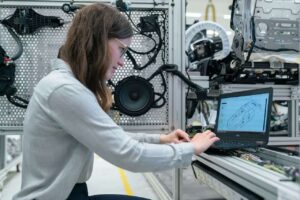
Home / EV Charging News / Electric Cars and the Gig Economy: A Greener Road to Last-Mile Delivery
In this article, we’ll explore the dynamic intersection of electric cars and the gig economy. The growing use of electric vehicles (EVs) by gig workers and delivery drivers is revolutionizing last-mile delivery and reducing emissions. Let’s delve into the key aspects of this transformation.
The gig economy, characterized by freelance, part-time, and on-demand work, has experienced significant growth, especially in delivery services. Last-mile delivery, the final stage of a product’s journey from a distribution center to its destination, plays a crucial role in the gig economy, driven by the surge in e-commerce.
Many gig workers and delivery drivers are making the shift to electric cars, reducing their carbon footprint and contributing to cleaner air in urban areas. Electric cars offer cost advantages, such as lower fuel and maintenance expenses, making them financially attractive to gig workers.
The use of electric cars in the gig economy significantly reduces greenhouse gas emissions, aligning with sustainability goals. Electric cars are quieter than traditional vehicles, leading to reduced noise pollution in urban neighborhoods. Moreover, electric vehicles do not emit tailpipe pollutants, contributing to better air quality in cities, especially in congested areas.
Expanding EV charging infrastructure in urban areas is essential to support the increased adoption of electric cars by gig workers. Gig workers often rely on vehicles with ample range, so addressing range anxiety is crucial for widespread electric car adoption in the gig economy.
Ride-sharing companies like Uber and Lyft are actively encouraging their drivers to transition to electric cars and offering incentives to do so. Major delivery companies, such as Amazon and UPS, are electrifying their delivery fleets and working with gig drivers to promote electric last-mile delivery.
As electric cars become increasingly integrated into the gig economy, a few key points will shape the path forward:
Electric cars are revolutionizing last-mile delivery in the gig economy, ushering in a more sustainable and environmentally responsible way of doing business. As more gig workers and delivery drivers make the switch to electric vehicles, the road to a greener future becomes clearer, benefiting urban areas, the environment, and all those who depend on the gig economy for their livelihoods.
The adoption of electric vehicles in the gig economy represents a significant step towards achieving sustainability goals. It not only reduces carbon emissions and noise pollution but also enhances air quality in cities. As electric cars become more affordable and charging infrastructure continues to expand, this transformation is expected to accelerate.
Government support through incentives and policies is crucial for the widespread adoption of electric cars in the gig economy. Collaborative efforts between policymakers, gig companies, and the automotive industry are vital to ensure that electric mobility becomes the norm in last-mile delivery.
As electric cars become the vehicle of choice for gig workers, we can anticipate several trends and developments:
The gig economy and electric mobility are joining forces to create a more sustainable and eco-friendly future for last-mile delivery. As gig workers and delivery drivers increasingly embrace electric cars, they not only reduce emissions and operational costs but also contribute to creating cleaner and quieter urban environments.
The path forward involves addressing infrastructure challenges, overcoming range anxiety, and strengthening policy support. With these efforts, the gig economy can continue its journey toward a greener, more efficient, and eco-conscious mode of last-mile delivery.
$4,150.00 Original price was: $4,150.00.$3,990.00Current price is: $3,990.00.
$10,690.00 – $11,390.00

Your Power Management Partner for Over 25 Years Future Generations Depend on Our Decisions Today ™
2024 © All rights reserved by CyberSwitching